Sphynx Cat
- February 15, 2024
- 0 comment
The Sphynx cat, renowned for its distinctive hairless appearance, is a captivating breed cherished by cat lovers worldwide. Originating from Toronto, Canada, in the 1960s, where a spontaneous genetic mutation led to the birth of the first hairless kitten named Prune, these unique felines have since been selectively bred to establish the Sphynx breed. Despite their lack of fur, Sphynx cats possess a soft, warm skin that comes in various colors and patterns, ranging from solid to tabby and tortoiseshell.

Beyond their striking appearance, Sphynx cats are cherished for their outgoing and affectionate personalities. They thrive on human companionship and are known to be playful, curious, and highly social animals. Regular grooming and skincare routines are essential to maintain their skin health and prevent dryness or sunburn. Overall, Sphynx cats make delightful and loving companions, bringing joy and warmth to any household with their unique charm and endearing personalities.
| Specification | Description |
|---|---|
| Coat Type | Hairless |
| Color | Various colors and patterns including solid, tabby, and tortoiseshell |
| Size | Medium to large |
| Weight | 6 to 12 pounds (males tend to be larger than females) |
| Lifespan | 8 to 14 years |
| Personality Traits | Outgoing, affectionate, playful, curious, sociable |
| Grooming Needs | Regular bathing and skincare routines to prevent oil buildup and maintain skin health |
| Health Considerations | Potential for skin issues, respiratory problems, dental issues; regular veterinary check-ups recommended |
| Dietary Requirements | High-quality cat food with balanced nutrition; occasional treats allowed |
| Training and Socialization | Intelligent and trainable; respond well to positive reinforcement; require socialization from a young age to develop confident personalities and positive interactions with humans and other pets |
| Compatibility | Generally get along well with other pets, including dogs and other cats; proper introductions and supervised interactions recommended |
| Origin | Toronto, Canada (1960s) |
| Breeding History | Bred selectively from spontaneous genetic mutation leading to the birth of the first hairless kitten named Prune |
| Popularity | Increasing popularity as pets due to unique appearance and affectionate nature |
Sphynx Cat: A Unique Feline Companion
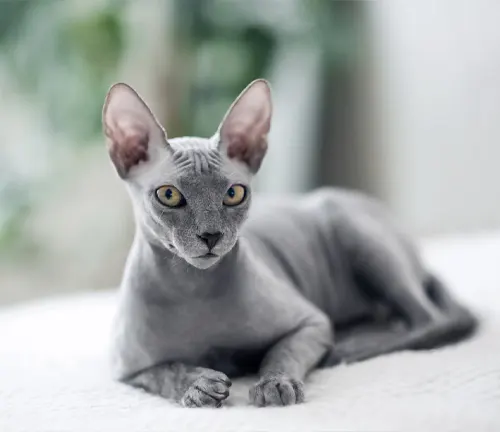
Sphynx cats, with their distinctive hairless bodies and inquisitive personalities, have captivated the hearts of cat enthusiasts worldwide. Originating from selective breeding efforts, these unique felines have become beloved pets for their affectionate nature and striking appearance.
History and Origin
The history and origin of the Sphynx cat breed can be traced back to the 1960s in Toronto, Canada. It all began with a natural genetic mutation that resulted in the birth of a hairless kitten named Prune. This spontaneous occurrence intrigued breeders who saw potential in developing a new and unique breed of cats.
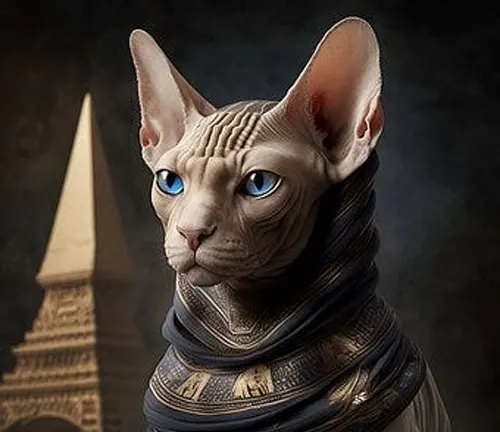
Prune, the founding feline of the Sphynx breed, captured the attention of cat enthusiasts with her striking appearance and affectionate personality. Breeders began selectively breeding hairless cats, incorporating Prune’s genetic lineage, to establish the foundation of what would later become the Sphynx cat breed.
Physical Characteristics
One of the most defining features of Sphynx cats is their lack of fur, which exposes their soft, warm skin. Despite their hairless appearance, Sphynx cats come in a variety of colors and patterns, ranging from solid to tabby and tortoiseshell.
Hairlessness
Perhaps the most notable physical trait of the Sphynx cat is its lack of fur. Unlike most other cat breeds, Sphynx cats are nearly or completely devoid of hair, giving them a unique and striking appearance. Their hairlessness exposes their soft, warm skin, which may have a fine layer of fuzz or feel like suede to the touch.
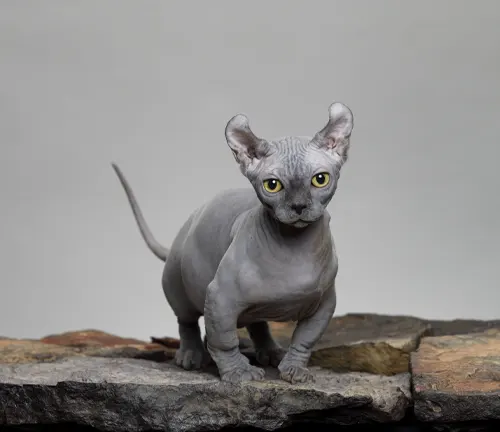

Muscular Build
Despite their lack of fur, Sphynx cats are muscular and sturdy in build. They have a medium to large-sized body with a solid bone structure and well-developed muscles. Their strong and athletic physique reflects their active and agile nature, allowing them to leap and play with ease.
Distinctive Facial Features
Sphynx cats have distinctive facial features that contribute to their unique appearance. They typically have large, expressive eyes set in a broad, slightly rounded head. Their ears are large and wide-based, with a slightly rounded tip. Some Sphynx cats may have wrinkled skin on their face, particularly around the muzzle and forehead, adding to their characteristic charm.

Personality Traits
Sphynx cats are known for their outgoing and affectionate personalities. They thrive on human companionship and enjoy being the center of attention. These playful and curious cats often form strong bonds with their owners and are highly social animals.
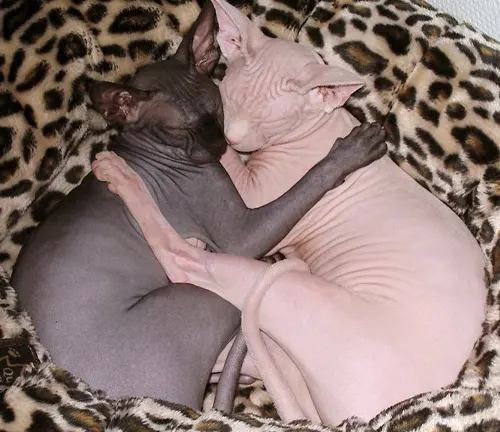
Affectionate
Sphynx cats are known for their affectionate nature and love for human companionship. They enjoy being close to their owners, often seeking out cuddles and affectionate interactions. Sphynx cats are typically social animals that thrive on attention and form strong bonds with their human family members.
Playful
Despite their elegant appearance, Sphynx cats have a playful and mischievous side. They enjoy interactive play sessions and are often curious and adventurous, exploring their environment with enthusiasm. Sphynx cats have a youthful energy that can keep them entertained for hours, whether chasing toys or engaging in interactive games with their owners.
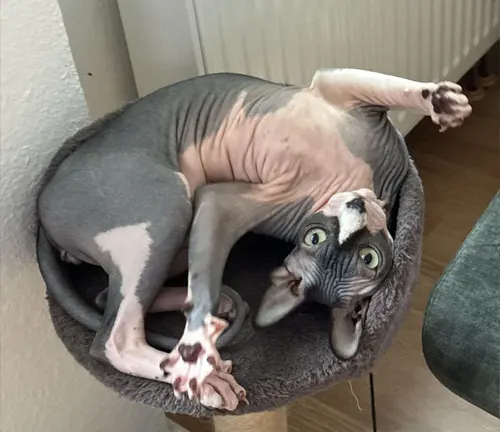
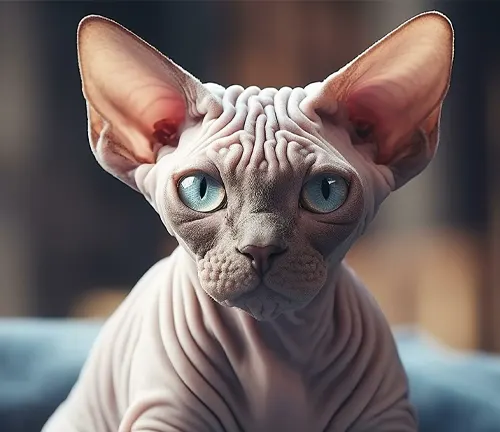
Social
Sphynx cats are highly social animals that enjoy the company of people and other pets. They are known for their outgoing and friendly personalities, often greeting visitors with curiosity and affection. Sphynx cats thrive in environments where they receive plenty of attention and interaction, making them excellent companions for households with multiple family members or other pets.
Care and Maintenance
Despite their lack of fur, Sphynx cats require regular grooming to keep their skin healthy and clean. This includes bathing to remove oil buildup and debris, as well as skincare routines to prevent dryness and sunburn.
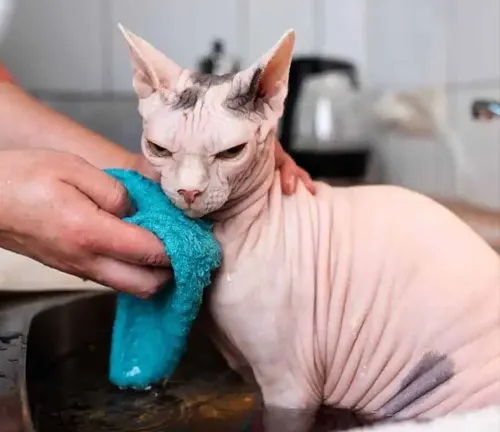

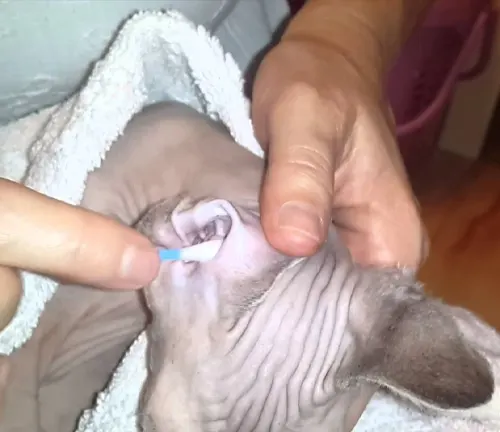
- Skin Care: Sphynx cats require regular skincare routines to keep their skin healthy and moisturized. Bathing them once a month with a mild, hypoallergenic cat shampoo helps remove oil buildup and debris. After bathing, gently pat their skin dry with a soft towel and apply a pet-safe moisturizer to prevent dryness.
- Sun Protection: Sphynx cats are susceptible to sunburn due to their exposed skin. Limit their exposure to direct sunlight, especially during peak hours, and provide shaded areas or protective clothing when outdoors. Additionally, consider using pet-safe sunscreen on areas prone to sunburn, such as the ears, nose, and skin with less pigmentation.
- Temperature Regulation: Due to their lack of fur, Sphynx cats may have difficulty regulating their body temperature. Ensure they have access to warm and cozy environments, especially during colder months. Providing soft bedding, heated cat beds, or cozy blankets can help keep them comfortable and warm.
- Nail Care: Trim your Sphynx cat’s nails regularly to prevent them from becoming too long or sharp. Use cat-specific nail clippers and be gentle to avoid cutting the quick, which can cause bleeding and discomfort. If you’re unsure how to trim your cat’s nails safely, consult your veterinarian or a professional groomer for guidance.
- Ear Cleaning: Clean your Sphynx cat’s ears regularly to remove wax and debris buildup. Use a soft, damp cloth or cotton ball moistened with a veterinarian-recommended ear cleaner to gently wipe the outer ear canal. Avoid inserting anything into the ear canal, as this can cause injury or discomfort.
- Dental Care: Dental hygiene is essential for Sphynx cats to prevent dental issues such as plaque and tartar buildup, gum disease, and tooth decay. Brush your cat’s teeth regularly with a pet-safe toothbrush and toothpaste formulated for cats. Additionally, provide dental treats or toys designed to promote oral health.
- Nutrition: Feed your Sphynx cat a balanced diet formulated to meet their nutritional needs. Choose high-quality cat food with protein as the main ingredient and limited fillers or additives. Monitor their food intake and adjust portion sizes as needed to maintain a healthy weight.
- Regular Veterinary Check-ups: Schedule regular veterinary check-ups for your Sphynx cat to monitor their overall health and address any potential issues early on. Your veterinarian can provide personalized recommendations for vaccinations, parasite prevention, and health screenings based on your cat’s age, lifestyle, and medical history.
Common Health Issues
While generally healthy, Sphynx cats may be prone to certain health issues, including skin conditions, respiratory problems, and dental issues. Regular veterinary check-ups and proper care can help prevent these issues.
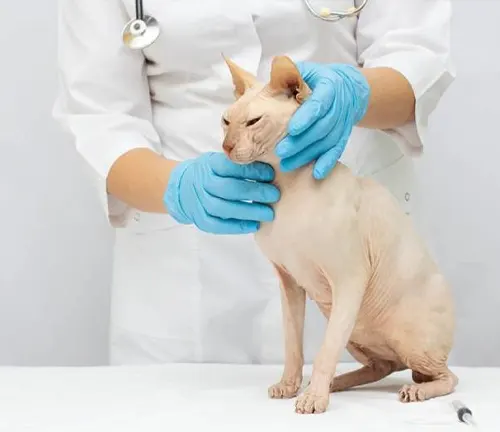
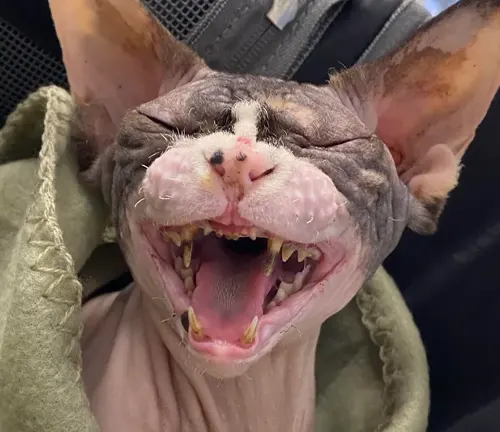
- Skin Conditions: Due to their lack of fur, Sphynx cats are susceptible to various skin conditions, including dermatitis, acne, and fungal infections. Regular skincare routines, such as bathing and moisturizing, can help prevent these issues, but it’s essential to monitor their skin for any signs of irritation or infection.
- Respiratory Problems: Sphynx cats may be prone to respiratory issues such as upper respiratory infections (URIs) and asthma. Environmental factors, stress, and exposure to allergens can exacerbate these conditions. Keep your Sphynx cat’s environment clean and free from potential respiratory irritants to minimize the risk of respiratory problems.
- Gastrointestinal Issues: Some Sphynx cats may experience gastrointestinal issues such as diarrhea, vomiting, or food sensitivities. It’s essential to feed them a balanced diet and monitor their food intake to prevent digestive upset. If your Sphynx cat experiences persistent gastrointestinal symptoms, consult your veterinarian for a thorough evaluation and dietary recommendations.
- Dental Problems: Dental issues, including periodontal disease, gingivitis, and tooth decay, are common in Sphynx cats. Regular dental care, such as brushing your cat’s teeth and providing dental treats or toys, can help maintain their oral health. Additionally, schedule regular veterinary dental cleanings to prevent the buildup of plaque and tartar.
- Heart Disease: Sphynx cats may be predisposed to certain heart conditions, such as hypertrophic cardiomyopathy (HCM), a genetic disorder that affects the heart muscle. Regular veterinary check-ups, including cardiac screenings, can help detect any potential heart issues early on. If your Sphynx cat is diagnosed with a heart condition, work closely with your veterinarian to develop a treatment plan and monitor their cardiac health closely.
Feeding Guidelines
Sphynx cats have specific dietary needs to support their high metabolism and maintain their body temperature. A balanced diet of high-quality cat food, supplemented with occasional treats, is essential for their health and well-being.
Balanced Diet
Provide your Sphynx cat with a balanced diet that meets their nutritional needs. Choose high-quality cat food formulated to support their overall health and well-being. Look for cat food with protein as the main ingredient and limited fillers or additives. Additionally, consider incorporating wet food into their diet, as it can help keep them hydrated and provide additional moisture.
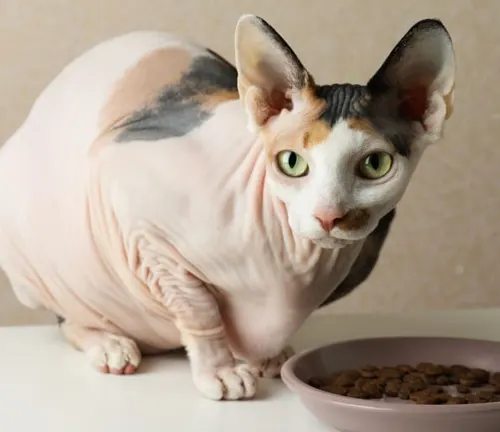
Portion Control
Monitor your Sphynx cat’s food intake and practice portion control to prevent overfeeding and obesity. Follow the feeding guidelines recommended by the cat food manufacturer based on your cat’s age, weight, and activity level. Avoid free-feeding or leaving food out continuously, as this can lead to excessive weight gain. Instead, establish a feeding schedule with measured meals to help maintain a healthy weight for your Sphynx cat.
Different Species
Solid Color Sphynx Cats
These Sphynx cats have a single solid color throughout their body without any patterns or markings.
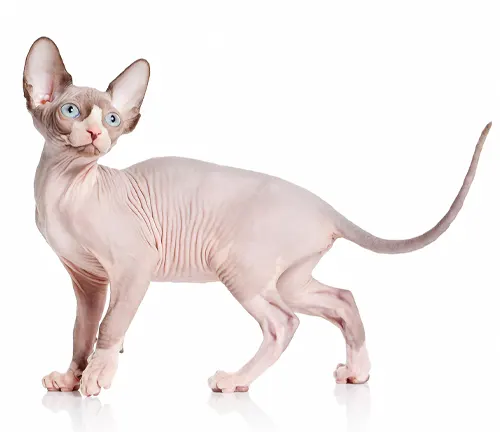
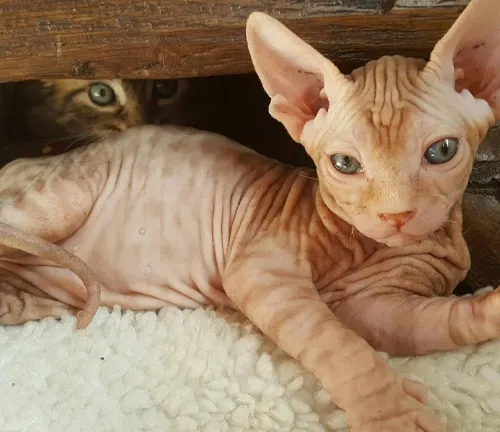
Tabby Sphynx Cats
Tabby Sphynx cats have a distinctive striped or swirled pattern on their skin, which can come in various colors such as brown, gray, or orange.
Tortoiseshell Sphynx Cats
Tortoiseshell Sphynx cats have a unique multicolored coat pattern with patches of black, orange, and cream.
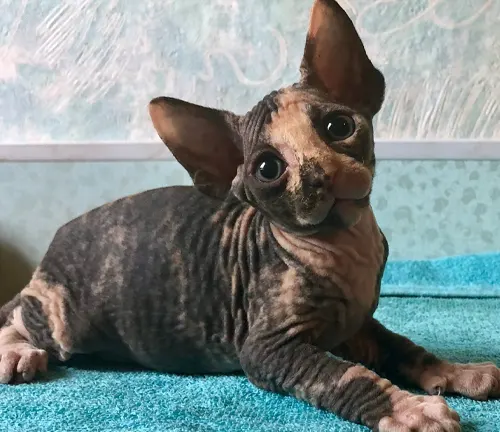
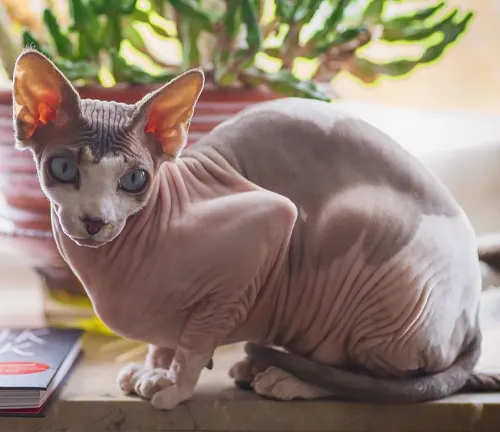
Bicolor Sphynx Cats
Bicolor Sphynx cats have two distinct colors on their skin, often in a pattern such as white with patches of another color.
Calico Sphynx Cats
Calico Sphynx cats have a tricolor coat pattern consisting of white, black, and orange patches.
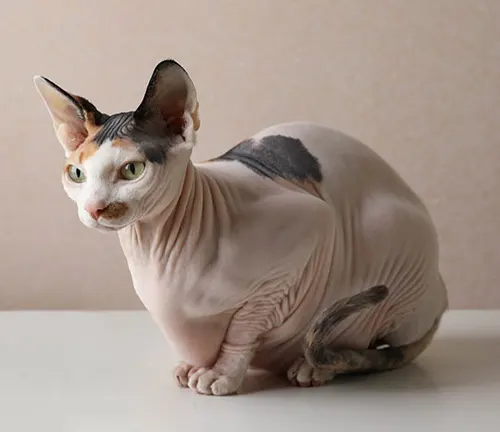
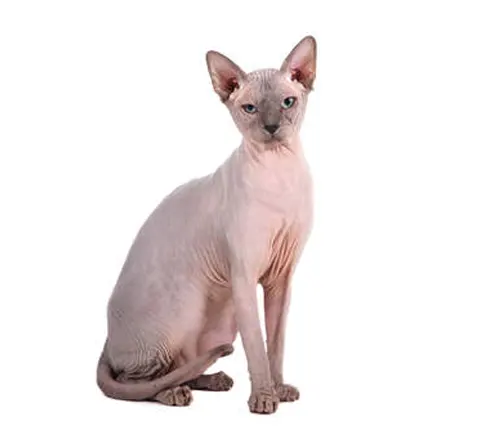
Pointed Sphynx Cats
Pointed Sphynx cats have a lighter body color with darker points on their ears, face, paws, and tail, similar to the Siamese breed.
Frequently Asked Questions (FAQs)
- Do Sphynx cats get cold easily?
Despite their lack of fur, Sphynx cats have a higher metabolism that helps regulate their body temperature. They may still appreciate warmth and cozy environments, especially in cooler climates, so providing soft bedding and maintaining a comfortable temperature indoors is recommended. - Are Sphynx cats more high-maintenance than other breeds?
Sphynx cats do require regular grooming and skincare routines to keep their skin healthy, but they are not necessarily more high-maintenance than other breeds. With proper care and attention, Sphynx cats can thrive as loving and low-maintenance companions. - Do Sphynx cats need sunscreen?
Yes, Sphynx cats may benefit from pet-safe sunscreen when exposed to direct sunlight for extended periods. Look for products specifically formulated for cats and apply them to areas prone to sunburn, such as the ears, nose, and skin with less pigmentation. - Are Sphynx cats more prone to health issues than other breeds?
While Sphynx cats may have a higher risk of certain health issues such as skin conditions and respiratory problems due to their lack of fur, they are not inherently more prone to health problems than other breeds. Regular veterinary check-ups and preventive care can help mitigate potential health issues. - Can Sphynx cats go outside?
Sphynx cats can go outside under supervision, but it’s essential to ensure their safety and protection from environmental hazards, predators, and extreme weather conditions. Many Sphynx cat owners opt to keep their cats indoors or provide secure outdoor enclosures to prevent accidents and keep them safe. - Do Sphynx cats shed?
Sphynx cats do not shed in the same way as furry breeds, but they may still produce some dander and oil, which can accumulate on their skin. Regular bathing and grooming can help reduce shedding and keep their skin clean and healthy. - Are Sphynx cats good with children?
Sphynx cats are generally good with children and enjoy their playful and affectionate nature. However, it’s essential to teach children how to interact gently and respectfully with cats to prevent accidental injuries or stress for the cat. - How much exercise do Sphynx cats need?
Sphynx cats are active and playful animals that benefit from daily exercise and mental stimulation. Interactive toys, climbing structures, and play sessions can help keep them physically and mentally engaged. - Do Sphynx cats have a strong odor?
Sphynx cats do not have a particularly strong odor compared to other breeds, but regular grooming and skincare routines are necessary to prevent oil buildup and keep their skin clean and odor-free. - Can Sphynx cats be left alone for long periods?
Sphynx cats are social animals that enjoy human companionship, so they may become lonely or anxious if left alone for extended periods. It’s best to provide regular interaction and enrichment activities to prevent boredom and separation anxiety.







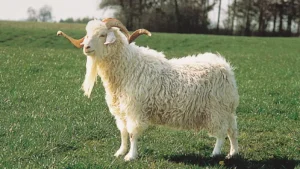


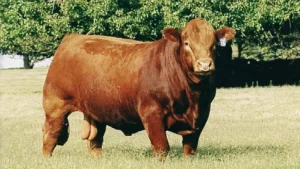
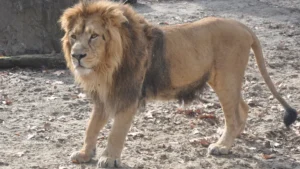

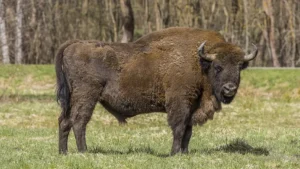
Leave your comment